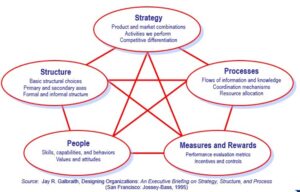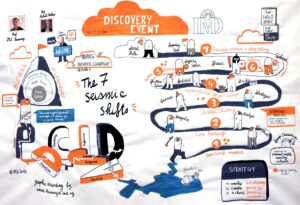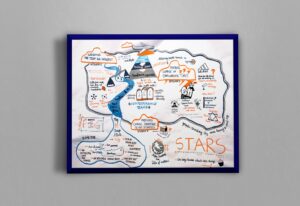There are many schools of thought on the difference between leadership and management, which can be more confusing than enlightening. To establish a common understanding of leadership, Professor Watkins defines effective leaders as those who “mobilize, focus and sustain sources of potential energy in people and organizations to achieve the desired goals.”
They define and communicate the company’s business mission/vision, establish business goals and strategies, design and transform organizational systems, shape organizational decision making, negotiate and build alliances, drive flawless execution and foster organizational learning and adaptation.
There are three levels of leadership: personal, people and business, each calling for different skills and capabilities. The biggest shift occurs in the transition from people to business leadership, when the need for both delegation and well-thought internal and external communication are crucial.
Seven Seismic Shifts in the Transition to Business Leadership
Research shows that there are seven seismic shifts1 that take place when leaders make the transition from leading one function to leading an enterprise, taking responsibility for profit and loss and the oversight of executives across corporate functions.
- Specialist to Generalist. Understanding key functions and learning how to evaluate and develop leaders in those functions.
- Analyst to Integrator. Establishing overall direction and leading teams in integrative decision-making and problem-solving. Understanding and managing core trade-offs (top-line vs. bottom line, long- vs. short-term, innovation vs. execution, sales vs. operations).
- Tactician to Strategist. Thinking strategically, recognizing patterns and being able to move fluidly between the big picture and the details. Having a game-playing mentality to anticipate competitors’ moves and countermoves and the ability to use powerful simplifications.
- Problem-solver to Agenda-setter. Many managers are promoted based on their effective problem-solving and crisis management skills, while business leaders need to define the problems the organization needs to solve, aligning and communicating priorities.
- Bricklayer to Architect. Understanding how to diagnose and design organizational systems and drive organizational change.
- Warrior to Diplomat. Being able to navigate the political currents of the organization and its environment, understanding how power, influence and culture work, diagnosing and building influence networks and alliances.
- Supporting Cast to Lead Role. Business leaders should be aware of the influence (even unintended) they have on the values, behaviour and culture of their organizations.
Although these seismic shifts are all equally important, we will focus on just two of them – from Tactician to Strategist, and from Bricklayer to Architect.
From Tactician to Strategist
This is one of the most essential shifts a leader undergoes in the transition from functional leader to business leader. The strategist must be able to recognize important patterns in complex environments, move effortlessly from the minutiae to the “big picture,” anticipate and influence the moves and countermoves of competitors.
According to Professor Rosenzweig, the essence of strategic thinking is the ability to recognize what drives business performance in your organization – a holistic understanding that is difficult to attain in just one particular function. The three major areas that drive business performance are:
- Industry – the competitive dynamics we face
- Strategy – the choices we make to compete in the industry
- Execution – how we mobilize resources to deliver results.
There is an ongoing debate as to what is the most important – strategy or execution. In reality, both are essential but to a different degree at different times depending on the company’s situation. In any case, business leaders have to be highly skilled at both.
Hambrick and Frederickson2 define strategy as “an integrated set of choices,” i.e. where to compete (what products/services to offer and markets to serve), what activities to perform, what competitive position to take (to differentiate ourselves), and what business model to adopt.
Strategy is both complex and simple at the same time. On the one hand, it draws on all functions, combines external forces and internal capabilities and involves the actions and counteractions of rivals. On the other hand, it is simply a set of choices a company must make.
Business leaders should be able to analyze and design their organizations so that strategy, structure, operating models and capabilities fit together effectively. This requires an understanding of the key elements of organizational architecture, as illustrated in the STAR model (see Figure 1). As a static exercise, the STAR model is an effective diagnostic tool. Nevertheless, the whole model should be dynamic and adapted to changing strategy and/or environment. When a leader decides to redesign their organization, preference should be given not only to restructuring but also to making small continuous adjustments in all the elements.
The first thing a leader should do after setting a new strategy is to adapt the organizational structure to fit, bearing in mind that there are no perfect organizational structures – it’s all about trade-offs. Only after that should he or she move to defining and adapting processes, upgrading people’s capabilities and skills and putting in place a system of KPIs and incentives.
Figure 1: The Star Model

Any efficient organizational structure should have clearly defined responsibilities, accountability and authority, and effectively combine activities. It can be organized across various dimensions: functions, businesses, geographies, customer segments, projects, etc. As companies evolve and add more regions, divisions, product lines and functions, they tend to end up with a complex and asymmetrical structure. This creates an additional challenge for business leaders in optimizing the structure to increase efficiency of business activities.
This challenge has gained more traction in recent years with increasing attention to agility. McKinsey defines organizational agility as the ability to quickly reconfigure strategy, structure, processes, people and technology toward value-creating and value-protecting opportunities.3 According to their research, agile units excel most often at strategy and people-related practices and outperform all other units in dynamism and stability.
Building an agile organization is a concurrent task especially in a modern, increasingly uncertain and rapidly changing environment. According to McKinsey,4 among the five main trademarks of an agile organization, the two fundamental elements are having shared purpose and vision as well as a network of empowered teams with clear flat structures and accountable roles.
Matching change strategy to the situation
In a new role, a business leader often has to initiate or inherit some sort of organizational transformation – from small incremental changes to significant restructuring. Few transformation projects are successful for various reasons, such as:
- No compelling case for change
- “One best way” thinking
- Lack of senior team alignment
- No dedicated change team
- Insufficient co-creation during the design phase
- Poor stakeholder management
- Insufficient resources for implementation
- Lack of disciplined follow-through and accountability
- Lack of measures of progress
- Required new competencies not developed.
Yet most importantly, newly appointed business leaders have a “one fits all” assumption and tend to neglect the fact that the same strategy will have different, frequently opposing outcomes in different situations – a change strategy required for a crisis management situation (turnaround) will not work in the sustaining success situation. To succeed in organizational transformation, business leaders should match their change strategy to one of the five business situations they inherit (or a mix):
- Start-up, or assembling capabilities to get new business initiative off the ground.
- Turnaround, or saving a business or initiative that is deeply in trouble.
- Accelerated growth, or managing a rapidly expanding business.
- Realignment, or reenergizing previously successful business that faces problems. Very often this situation is the hardest to succeed in.
- Sustaining success, or sustaining the good performance of a business.
Here, business leaders should be able to differentiate between the need for a turnaround situation and a realignment. When urgent needs require urgent actions and people know something needs to be done but not what, a turnaround is required. When the urgency or issue is not apparent and the leader needs to show people that there is a problem,” a realignment is necessary.
Leading the team you inherit
While most business literature focuses on building high-performing teams, in reality, newly appointed business leaders rarely have the opportunity to build their own team, rather they inherit someone else’s. The new leader has to be able to quickly assess and shape the team to take it in new directions. The type of team and the situation in which it is operating play an important role, for example, the extent of interdependence among team members, the roles they need to play, the business situation the company is facing, company culture and resources, and so on.
To build a high-performing team, a new leader needs to:
- Have the right people in the right roles by assessing and evolving the team membership to ensure that current roles and responsibilities make sense, while at the same time ensuring the right balance between stability and change and the need for high performance versus development potential.
- Drive powerful alignment by ensuring a shared purpose and consistency in the team in terms of what needs to be accomplished and what strategy to adopt to get there, and making sure people feel motivated.
- Enhance operational efficiency by deciding what will optimize efficiency and how to work effectively together. Organize the team to be flexible and efficient through regular meetings, fixed agendas, shared leadership, sub-teams, etc.
- Foster effective collaboration by understanding how to make decisions and solve problems and deciding what the team’s operating principles should be, e.g. sharing of information, mutual trust (no hidden agendas), collaboration and [healthy] competition, psychological safety and conflict management. Task-related conflicts can turn into relationship conflicts if not resolved and quickly reduce the motivation and effectiveness of the team.
Key Takeaways
- In moving up from functional to business leadership, a leader has to undergo seven seismic shifts in skills and capabilities, including shift from tactical to strategic thinking and from bricklayer to architect mentality.
- The business leader as an architect should clearly understand the entire organization and be able to reconfigure it. This does not mean that the first move should be to restructure or perform a major redesign. Instead, small continuous adjustments to all the elements of the STAR model should be implemented.
- When undertaking a major organizational transformation, business leaders should carefully consider their business situation and adapt the change strategy accordingly.
- Although every leader is eager to have a high-performing team, they are rarely able to build it themselves when moving up to business leadership. The majority have to work with the teams they inherit from their predecessors. Successfully managing inherited teams requires a different approach, careful assessment of the team and conscious choices.


References
(1) Michael D. Watkins. “How Managers Become Leaders.” Harvard Business Review, June 2012, http://hbr.org/2012/06/how-managers-become-leaders
(2) D.C. Hambrick and J.W. Frederickson. “Are you sure you have a strategy.” The Academy of Management Executive, 15:4, November 2001
(3) “How to create an agile organization.” McKinsey Quarterly, October 2017 https://www.mckinsey.com/business-functions/organization/our-insights/the-five-trademarks-of-agile-organizations
(4) Wouter Aghina, Aaron De Smet, Gerald Lackey, Michael Lurie, and Monica Murark, “The five trademarks of agile organization”, McKinsey Quarterly, October 2017, https://www.mckinsey.com/business-functions/organization/our-insights/the-five-trademarks-of-agile-organizations
(5) Michael D. Watkins. “Leading the Team You Inherit.” Harvard Business Review, June 2016 https://hbr.org/2016/06/leading-the-team-you-inherit









